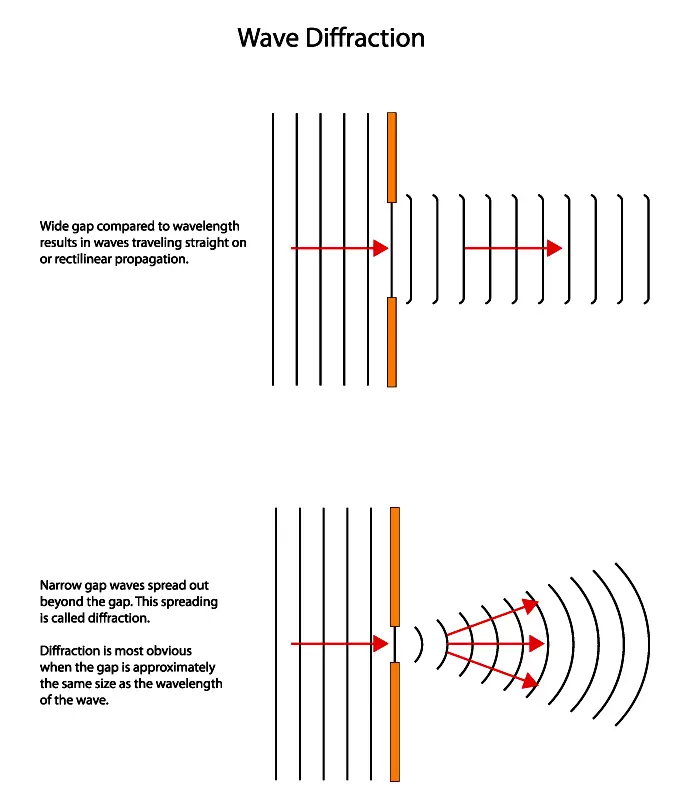Diffraction

Table of Contents
What is Diffraction?
Diffraction is a wave phenomenon that occurs when a wave encounters an obstacle or passes through a narrow aperture, causing it to bend and spread out. This effect can be observed with all types of waves, including light, sound, water, and electromagnetic waves.
When waves encounter an obstacle or pass through a slit that is comparable in size to their wavelength, they bend around the edges of the obstacle or through the openings rather than continuing in a straight line. This bending allows waves to reach areas that would otherwise be in shadow if the waves traveled only in straight lines.
As the diffracted waves spread out, they can interfere with each other, creating a pattern of light and dark bands or other complex patterns. These interference patterns result from constructive interference (where waves combine to increase amplitude) and destructive interference (where waves combine to decrease amplitude or cancel each other out).
The Science of Diffraction
Wave Nature
Diffraction is when light or sound waves hit an obstacle and spread or bend around it. Think of it as water waves hitting a rock and then wrapping around it to continue their journey. This phenomenon occurs because waves, unlike particles, can spread out and move in new directions when they encounter barriers. The bending of these waves leads to patterns of spreading and contraction, creating effects like the colorful bands of light seen in a rainbow or the echoing sound in a large hall.
Moreover, the extent to which waves bend or diffract depends on their wavelength (the distance between wave peaks) and the size of the obstacle or opening they encounter. Larger wavelengths or smaller openings cause more bending. This is why we can hear sounds around corners or radio signals can reach places not in a direct line of sight.
In daily life, diffraction explains why we can hear someone speaking even if we’re in another room with the door slightly open. The waves bending around the door carry the sound to us.
Huygens-Fresnel Principle
The Huygens-Fresnel principle provides a detailed explanation for the phenomenon of diffraction. According to this principle, every point on a wavefront is a source of tiny, secondary wavelets that spread out in all directions. These secondary wavelets are spherical and emanate from the wavefront at every point where the wave encounters an obstacle or passes through an aperture.
This concept helps visualize how waves propagate through space and interact with objects.As these secondary wavelets move forward, they overlap and interfere with each other. Where they meet in phase (peaks aligning with peaks, and troughs with troughs), they combine to create regions of constructive interference, resulting in increased wave amplitude.
Conversely, where they meet out of phase (peaks aligning with troughs), they cause destructive interference, leading to decreased wave amplitude or cancellation. The superposition of these wavelets, with their individual contributions of constructive and destructive interference, forms the complex diffraction patterns we observe.
For instance, in light diffraction, this can result in a series of bright and dark fringes. This principle not only explains diffraction but also elucidates other wave behaviors such as reflection and refraction, demonstrating the wave-like nature of light and other phenomena.
Diffraction and Wavelength
Diffraction’s relationship with wavelength and the size of obstacles or apertures is central to understanding how and why diffraction patterns vary. The degree of diffraction, or the amount by which a wave spreads out after encountering an obstacle, is closely tied to the wave’s wavelength—the distance between successive peaks of the wave. When a wave passes through an aperture or around an obstacle, longer wavelengths, such as red light or lower frequency sound waves, spread out more than shorter wavelengths, like blue light or higher frequency sounds.
This difference in diffraction is due to how waves interact with openings or barriers relative to their wavelength. When the size of the aperture or obstacle is much larger than the wavelength, the wave largely continues straight, with only slight bending at the edges, a phenomenon noticeable with shorter wavelengths. However, when the wavelength is comparable to or larger than the size of the aperture or obstacle, the wave bends significantly, creating more pronounced diffraction effects.
For example, in optics, this principle explains why red light, which has a longer wavelength than blue light, can bend more around objects and create broader diffraction patterns. In acoustics, it’s why low-frequency sounds can bend around walls and travel longer distances, while high-frequency sounds tend to travel in straighter lines and are blocked more easily by obstacles.
Diffraction vs. Refraction
Diffraction is about the bending and spreading of waves around the edges of an obstacle or through small apertures. It occurs with all types of waves, including light, sound, and water waves, when they encounter an object that disrupts their path. The extent of diffraction depends largely on the wave’s wavelength and the obstacle’s size or opening. This process leads to the formation of interference patterns, which are characteristic of diffraction, showing bands or fringes of varying intensity.
Refraction, on the other hand, involves the change in direction of waves as they pass from one medium to another, causing a change in speed. For example, when light waves travel from air into water, they slow down and bend towards the normal line (an imaginary line perpendicular to the surface at the point of entry). This bending is due to the difference in the wave’s speed in the two media. Refraction is why a pencil looks bent when partially submerged in water. It is the principle behind lenses and their ability to focus light.
While both diffraction and refraction involve the bending of waves, the underlying causes and the resulting phenomena are distinct. Diffraction is associated with the wave’s interaction with objects and its subsequent spreading and interference. At the same time, refraction is related to the wave’s speed changes and direction as it transitions between different media.
Related Links
Amplitude (Physics)
Sound
The Doppler Effect
Refraction